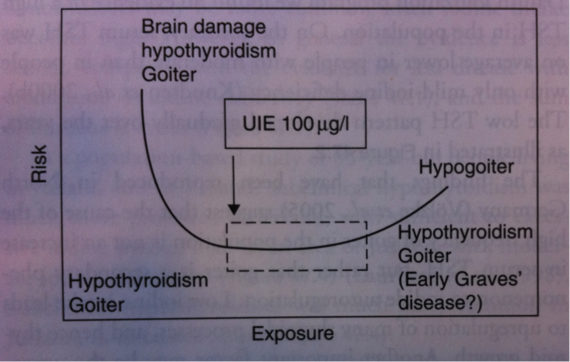
Over the last few years, iodine has become a hot topic of debate in the nutrition world. Suddenly, we are seeing books about it, new supplements on the market and specialized tests for it. I can think of no other mineral that is the source of as much confusion or controversy.
The controversy comes about because many authors are recommending high-dose iodine with the hope that it will improve health. Since my practice focuses on thyroid disease, I see all the unfortunate cases where high-dose iodine goes wrong.
Remember how Goldilocks wanted her porridge not too hot, but not too cold, and her bed not too hard, but not too soft? Iodine is like this. It is the Goldilocks mineral: Too little is not good, and too much is not good. As vital as it is for your health, iodine can become toxic by as little as a few hundred extra micrograms.
How much do you need and how can you know if you're getting enough?
Your thyroid needs iodine as a building block when it makes hormones. If you do not have enough, it cannot make the hormones that are vital to your body's repair and metabolism. In many parts of the world, this is a big problem. It has been estimated that as many as 2 billion people around the world have suffered brain damage because a lack of iodine hurt their thyroid [1]. This is why iodine is added to table salt in many parts of the world, including America.
If iodine is good for you, shouldn't you just try to get lots of it? Here is where the story gets tricky.
Unlike iodine, most nutrients are pretty simple. Unless you're badly deficient, the amount in your bloodstream is enough to meet your body's needs. Iodine is pretty different. Your thyroid has a special pump because it needs much more than your blood can carry. Once this pump pulls iodine inside of your thyroid, your thyroid makes hormones that speed your metabolism. These hormones are so powerful that if you had too much, your heart could quit working [2]. Thankfully, the iodine pump has safety mechanisms, so a little bit extra on occasion is not fatal. It works a lot like a fuse, if you get a high dose of iodine, you blow the fuse, and your thyroid quits working for a few weeks.
You may remember, during the Fukushima disaster in Japan, when there was talk of using potassium iodine pills. If you were exposed to radioactive iodine, and it entered your thyroid, it could raise your risk for thyroid cancer years down the road. However, if you knew you were at risk of being exposed to radioactive iodine in the next few days, and you took a high dose of iodine, that could blow the fuse and prevent you from absorbing the dangerous iodine for the next few days.
The tricky thing about iodine is that if you have too little, there's not enough to meet the nutritional requirements, but if you have too much, you blow the fuse and your thyroid quits working [3]. Too little hurts your thyroid, too much hurts your thyroid.
A collection of hundreds of human studies has condensed this idea into the following graph [4]:
The left side, where the line goes up, represents the risks of too little, the right side shows the risks of too much. It is so easy to think that if too little is bad, more is better. This graph shows otherwise.
The box around the lowest part of the line is where you want to be, and it represents about 100-300 micrograms daily. That is where your thyroid works the best. Good thyroid function keeps you lean and energized. If your thyroid function is off, you might have symptoms like unexplained fatigue, easy weight gain, headaches, hair loss, poor libido, muscle or joint pain or digestive disturbances.
How can you get enough?
- Use iodized salt or sea salt.
- Have sea veggies like nori, wakame, or dulse 1-2 times per week.
- Eat fish and seafood twice weekly.
- Have organic vegetables each day.
If you have thyroid disease or others in your family do, you may be more at risk of the danger of too much. If you are on thyroid medications, you already receive substantial amounts of iodine in them and are especially at risk for getting too much.
Here are a few more tips:
- Avoid kelp supplements and kelp as a food.
- Avoid iodine supplements.
- Avoid iodine added to supplements (like multivitamins) if you are on thyroid medicine or if you are at risk for thyroid disease.
There is a detailed and well-referenced article I've written about the claims made in the iodine controversy here.
If you would like further reading on iodine, here are some of my favorite resources:
The Agency for Toxic Substances and Disease Registry (ATSDR) has an exhaustive listing of over 200 pages of data, summarizing human studies on toxicity of iodine: http://www.atsdr.cdc.gov/toxprofiles/tp158-c3.pdf
The agency also has 172 excellent references on iodine metabolism: http://www.atsdr.cdc.gov/toxprofiles/tp158-c9.pdf
The CDC report on iodine requirements in humans: http://www.cdc.gov/nutritionreport/part_4a.html.
Iodine status worldwide from the World Health Organization: http://www.who.int/vmnis/iodine/status/en/index.html.
The Iodine Global Network, working to eliminate global iodine deficiency: http://www.ign.org/.
References:
[1] World Health Organization. Sustaining the elimination of iodine deficiency disorders (IDD.) http://www.who.int/nmh/iodine/en/. Accessed 4.24.15.
[2] Ching GW, Franklyn JA, Stallard TJ, Daykin J, Sheppard MC, Gammage MD. Cardiac hypertrophy as a result of long-term thyroxine therapy and thyrotoxicosis.
Heart. 1996 Apr;75(4):363-8.
[3] Whitcomb RC Jr, Ansari AJ, Buzzell JJ, McCurley MC, Miller CW, Smith JM, Evans DL.
A public health perspective on the U.S. response to the Fukushima radiological emergency. Health Phys. 2015 Mar;108(3):357-63. doi: 10.1097/HP.0000000000000198.
[4] Image Source: Comprehensive Handbook of Iodine Ed. Preedy V. Burrow G, Watson R. Elsevier 2009.
